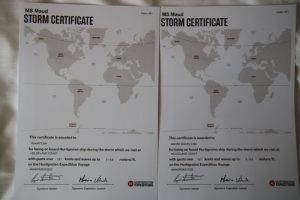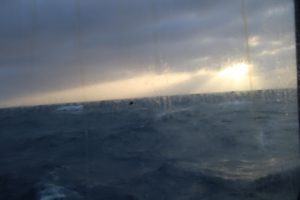At 08:00 a member of the team was awakened by 3 waves from the ongoing storm rattling underneath the ship as if we were going over speed humps. Just before 9:30 a.m. the Captain addressed us and said, “during the night we had experienced 8m waves and storm force 9 – 10 winds which were expected to lessen during the late morning”. We could see the clearer weather in the south from our breakfast table and also a small cargo ship that was seemingly struggling in the high seas. At this time we had 460 nautical miles to go to reach Dover and he estimated us arriving there on Wednesday around 7:00 – 8:00 a.m. He also mentioned that the conditions at this time are like a normal ‘January sea’ for these parts.
Every day there is a fish dish and some of the best has been Lofoten cod. The Lofoten Islands are an important and expanding cold-water fishing ground. Here the warmer waters from the Gulf Stream/North Atlantic Drift meet the cold waters from the Barents Sea which is the ideal conditions for the growth of plankton which the fish eat. The spawning of the winter cod and the amounts of fish processed changed the world. The winter cod from the Arctic generally arrive of the Lofoten Islands in January. Apparently it is rare, but in some years, it is possible to have this cod for Christmas dinner. By February the fish have spawned and the fishing boats, mostly from Norway, arrive in readiness to fill their nets. Children from the age of 5 or 6 to the end of schooling are given time off their studies to do the traditional job of cutting away the cod tongues, which are a delicacy. From February to June the cod is dried on racks in the open air which stretch for miles along the islands’ coastline. This dried cod is exported to Spain, Portugal and Italy. The best of the cod, which can weigh 60kg each, is gone by the end of April.
From the 11th century wind dried cod (stockfish) enabled Vikings and early explorers to cross the oceans with food that would not decay. The Lofotens supplied Europe’s demand for this fish but the British, in the 16th century, wanted a ‘Brexit’ from the Hanseatic League and started fishing off Iceland and Newfoundland. They also realised that they could not wind dry the cod on a ship because it would be constantly wet and just make a mush. It was the Icelanders who used salt to cure the fish that was the success of the British stockfish industry. The bulk of this salted cod was exported to the Iberian Peninsula and food, wine and silver were brought back to British ports such as Bristol. The workers of the British Empire across the World were fed by this stockfish industry. Today the biggest importer of fish heads in the world is Nigeria. This industry shows just how much cod there was but even with restrictions upon how much can be caught this is still a massive industry for Norway.
During the afternoon we continued southwards, off Aberdeen and later Edinburgh, but all the time closer to Denmark and with the winds dropping and a little chop the evening is becoming pleasant.





